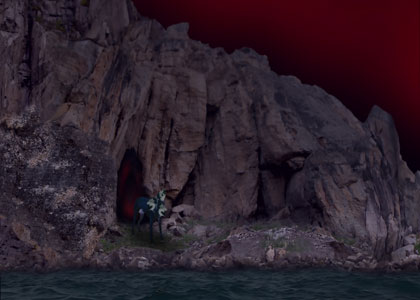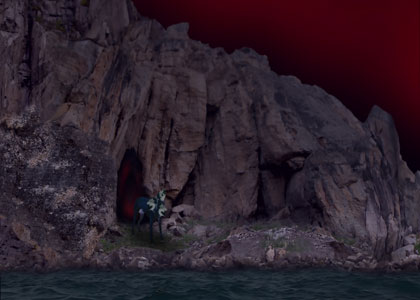Eden Auerbach Ofrat: Terminal (Homage to Arnold Böcklin)
Curator: Drorit Gur Arie
26/11/2015 -
26/03/2016

“As I was walking among the fires of
hell, delighted with the enjoyments
of Genius, which to Angels look like
torment and insanity, I collected
some of their Proverbs.”
—William Blake, The Marriage of
Heaven and Hell
In Judaism, Sheol is the netherworld. Human beings descend there after death by God’s will— “The Lord brings death and makes alive; he brings down to the grave and raises up” (1 Samuel 2:6)— and may therefore ascend once again to the land of the living. Sheol is also Abaddon, the place of destruction, and the abyss of oblivion, the place concealed from humans, to which they have no access. Such ideas find even more acute expression in Greek mythology, where the World of the Dead is called by many names, including Hades, after the “invisible” god of the underworld. In this mythology, the souls of the dead belong to Hades, their ruler, who forbids them from leaving his kingdom. Any attempt to bring someone back from Hades is doomed to failure, as one recalls from the stories of Persephone and of Orpheus and Eurydice. Such myths leave the struggle between life and death undecided. Orpheus did manage to go down to the underworld and extract his loved one from there, but at the last moment he looked back and lost her forever. And the beautiful Persephone, the personification of fertility and abundance on earth, was abducted by Hades, who tricked her by feeding her some pomegranate seeds before letting her exit his kingdom. Since she tasted food in the underworld, she was obliged to return to it every winter, forever trapped between the kingdom of light and the bowls of the earth. What is a museum collection if not an underworld of art pieces kept, untouched, under the earth, like corpses, waiting for the eye of a curator-god to choose and bring them back to life, if only for a few months, before they are returned to the nether regions once again? The museum’s registrar may be likened to Charon, the ferryman of Hades who carries the souls of the newly deceased across the river Styx, which surrounds the world of the dead and divides it from the world of the living.
Eden Auerbach-Ofrat’s new work explores this notion in two spaces: the museum’s permanent collection gallery and the hallway leading down to the collection’s storage rooms. In these works, as in her previous pieces, the world of mythology and the actual world are intertwined. Auerbach-Ofrat grouped works from the collection of the Petach Tikva Museum of Art and her video likens the gallery to a river bank which accompanies these works as they sail along the river Lethe—the river of forgetfulness, another of the rivers of the Greek underworld. On the river bank itself, the gallery’s floor, stand sculptures, as if awaiting their time to sail, too. Another video, screened in the hallway leading down to the collection’s storage rooms, presents the point of view of those who are sailing to Hades’ kingdom. Cerberus, the three-headed hound of Hades, moves back and forth on the river bank, deterring those arriving and standing guard against anyone leaving the collection cave. The aspiration of museums—ostensibly contrary to that of Hades, who jealously hangs on to his subjects—is to revitalize their collections, expose them to the light of day and breathe new contextual and interpretive life into them. However, they are also fearful lest the pieces in their collections be harmed in the process, for they are even more fragile in “death” than they were in life. Therefore, the wish to preserve them forever often trumps the desire to exhibit and return them to public and cultural consciousness. Auerbach-Ofrat refers to the two-way movement between the underground space (storage room) and the upper one (exhibition gallery), but does so from the point of view of the works of art. The onlookers become viewers in the full sense of the word, that is, viewers of a specter that is an inverted reflection of our world. We observe forgetfulness as if through the eyes of the sculptures, removed from either the forgetfulness or the historical memory of the collection’s storage rooms only to remain abandoned on shore.
Unlike other entities that inhabit the world invoked by Auerbach-Ofrat, we may decide whether to go out again into the light or remain in the darkness of the gallery and turn our gaze directly on the abyss of the culture consigned to oblivion here and now.


